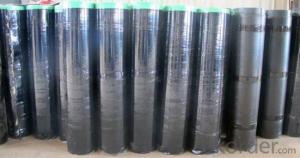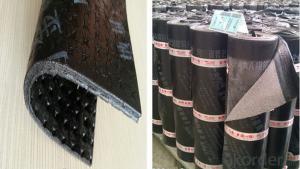SBS-Modified Bitumen Waterproof Membrane with Polyester Fiber and PE Film
- Loading Port:
- Tianjin
- Payment Terms:
- TT OR LC
- Min Order Qty:
- 1000 m²
- Supply Capability:
- 500000 m²/month
OKorder Service Pledge
OKorder Financial Service
You Might Also Like
SBS-PYPE is a waterproofing modified bitumen base sheet consisting of styrene-butadiene-styrene (SBS) modified asphalt reinforced with polyester fiber covering with polyethylene surfacing. There have two kinds of thickness: 3 mm, 4 mm。
We have two kinds of type in our company。They are I type and II type。They have differentt kinds of low temperature flexibility。
This type is 3mm thickness,type I。
If you want to know more about us,call the salesman of CNBM International Corporation (CNBM International) 。
CNBM INTERNATIONAL CORPORATION
Address:17th Floor, NO.4 Building, Zhuyu Business Center, Shouti South Road,Haidian District, Beijing,China
Post Code:100048
Tel:(86-10)68796888
Fax:(86-10) 68796668
Email:marketing@okorder.com, hr@okorder.com
- Q: Does a waterproofing membrane require any specific cleaning or maintenance procedures?
- Yes, a waterproofing membrane does require specific cleaning and maintenance procedures to ensure its longevity and effectiveness. Regular cleaning and maintenance help to prevent the buildup of debris, dirt, and other contaminants that can compromise the membrane's ability to keep water out. The specific cleaning and maintenance procedures can vary depending on the type of waterproofing membrane used, but some general guidelines apply. Firstly, it is important to regularly inspect the membrane for any signs of damage, such as cracks, tears, or deterioration. If any issues are detected, they should be promptly repaired or replaced to prevent further damage. In terms of cleaning, it is recommended to remove any loose debris or dirt from the membrane surface using a soft-bristle broom or a leaf blower. Avoid using harsh chemicals or abrasive materials that can damage the membrane. Instead, use a mild detergent or specialized cleaning solution recommended by the manufacturer. Gently scrub the surface with a soft brush or sponge, and rinse thoroughly with clean water. Additionally, it is crucial to keep the surrounding drainage systems clear and free from any obstructions. Regularly inspect and clean gutters, downspouts, and drains to ensure proper water flow and prevent any potential water damage. Lastly, it is advisable to have the waterproofing membrane professionally inspected and maintained on a regular basis. This can help identify any potential issues early on and ensure that the membrane is functioning at its optimal level. Overall, by following these specific cleaning and maintenance procedures, you can prolong the lifespan of the waterproofing membrane and maintain its effectiveness in preventing water infiltration.
- Q: Can a waterproofing membrane be used for theaters or concert halls?
- Yes, a waterproofing membrane can be used for theaters or concert halls. Waterproofing membranes are commonly used in construction to protect buildings from water damage. The membrane can be applied to various surfaces, including walls, floors, and roofs, helping to prevent water penetration and moisture-related issues. In theaters or concert halls, where there may be a significant risk of water damage due to heavy rain, leaks, or potential spills, using a waterproofing membrane can provide an extra layer of protection and help preserve the structural integrity of the building.
- Q: Are waterproofing membranes resistant to impact damage?
- Yes, waterproofing membranes are generally designed to be resistant to impact damage. They are often made with durable materials such as PVC or TPO that can withstand moderate impacts without compromising their waterproofing capabilities. However, the level of impact resistance may vary depending on the specific type and quality of the membrane.
- Q: Can a waterproofing membrane be used on below-grade foundations?
- Indeed, below-grade foundations can benefit from the application of a waterproofing membrane. It is highly advisable to utilize this method in order to avert water penetration and safeguard the foundation against moisture-related harm. By acting as a barrier, the membrane effectively obstructs the infiltration of water into the foundation walls, thus preventing complications like leaks, mold growth, and structural deterioration. Moreover, waterproofing membranes are specifically designed to endure the elevated water pressure commonly encountered in below-grade surroundings, rendering them an optimal choice for shielding foundations in basements and other below-ground edifices.
- Q: Can a waterproofing membrane be used in areas with high levels of moisture and humidity?
- Areas with high levels of moisture and humidity can benefit from the use of a waterproofing membrane. These specialized membranes are designed to safeguard surfaces against water infiltration, making them an excellent choice for moisture-rich environments. Constructed from materials such as rubber, PVC, or bitumen, these membranes possess water-resistant properties that effectively prevent water from permeating through. Some waterproofing membranes even offer additional features, such as vapor barriers or breathable qualities, enabling them to be utilized in areas with elevated humidity levels. It is crucial, however, to select the appropriate type of waterproofing membrane that aligns with the specific conditions and requirements of the area to guarantee optimal performance and durability.
- Q: Can a waterproofing membrane be used on precast iron surfaces?
- Yes, a waterproofing membrane can be used on precast iron surfaces. A waterproofing membrane is a thin layer of material that is applied to a surface to prevent the penetration of water or moisture. It can be applied to a variety of surfaces, including precast iron surfaces. The waterproofing membrane acts as a barrier, preventing water from seeping into the precast iron and causing damage such as rust or corrosion. This can be particularly important in areas where the precast iron surface is exposed to water or moisture, such as in outdoor installations or areas with high humidity levels. The use of a waterproofing membrane on precast iron surfaces can help to extend the lifespan of the structure and maintain its structural integrity.
- Q: Why is the top cover of the basement waterproofing? While the floor has to empty shop?
- Waterproof construction methods are generally reflected in the construction drawings. If not, please consult the designer. A waterproof, full of sticky. Secondary, sticky or sticky. Construction waterproof with waterproof material. According to each of the different basement waterproofing, the construction team will have its own waterproof concept and specific construction requirements.
- Q: Can a waterproofing membrane be used on planter boxes?
- Planter boxes can indeed benefit from the use of a waterproofing membrane. Typically employed to prevent water from seeping through surfaces, a waterproofing membrane safeguards the wood or other materials of the planter box from moisture damage. When applied to the interior, this membrane acts as a barrier, stopping water from infiltrating the material and potentially causing decay or rot. Consequently, the planter box's lifespan is prolonged, ensuring it remains in excellent condition for an extended period. Moreover, the waterproofing membrane aids in retaining moisture within the planter box, which proves advantageous for the growth of plants or flowers. Overall, the application of a waterproofing membrane enhances protection and durability for planter boxes.
- Q: Can a waterproofing membrane be used for soundproofing purposes?
- Yes, a waterproofing membrane can be used for soundproofing purposes to some extent. While its primary function is to prevent water penetration, it can also help to reduce sound transmission. Waterproofing membranes are typically made of materials that have good acoustic properties, such as rubber or a combination of rubber and asphalt. These materials can absorb and dampen sound waves, thereby reducing the amount of noise that passes through a wall or floor. However, it is important to note that the soundproofing effectiveness of a waterproofing membrane may not be as high as that of specialized soundproofing materials like acoustic panels or insulation. Therefore, if soundproofing is the main goal, it is recommended to consider using dedicated soundproofing solutions in addition to or instead of a waterproofing membrane.
- Q: Can a waterproofing membrane be used for plant rooms or mechanical spaces?
- Yes, a waterproofing membrane can be used for plant rooms or mechanical spaces. Plant rooms and mechanical spaces are areas where equipment, machinery, or systems are installed, and they often contain pipes, tanks, or other components that require protection from water damage. A waterproofing membrane is a durable, flexible, and watertight barrier that can be applied to surfaces such as walls, floors, or ceilings to prevent water infiltration. By using a waterproofing membrane in plant rooms or mechanical spaces, you can ensure the longevity and functionality of the equipment and systems by protecting them from water leaks or moisture damage. Additionally, a waterproofing membrane can also provide a vapor barrier, preventing the buildup of condensation or humidity, which can be detrimental to sensitive equipment.
Send your message to us
SBS-Modified Bitumen Waterproof Membrane with Polyester Fiber and PE Film
- Loading Port:
- Tianjin
- Payment Terms:
- TT OR LC
- Min Order Qty:
- 1000 m²
- Supply Capability:
- 500000 m²/month
OKorder Service Pledge
OKorder Financial Service
Similar products
Hot products
Hot Searches
Related keywords
























